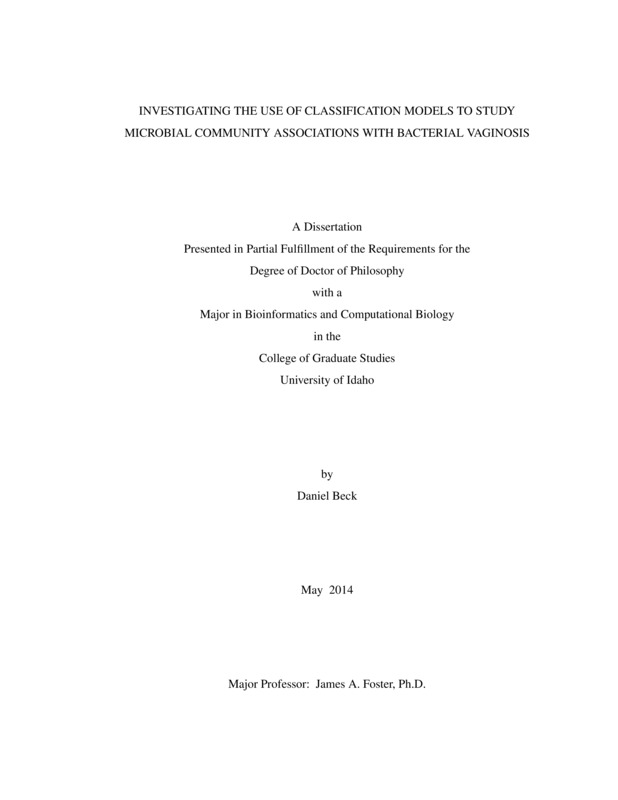Investigating the use of classification models to study microbial community associations with bacterial vaginosis
Beck, Daniel. (2014). Investigating the use of classification models to study microbial community associations with bacterial vaginosis. Theses and Dissertations Collection, University of Idaho Library Digital Collections. https://www.lib.uidaho.edu/digital/etd/items/beck_idaho_0089e_10212.html
- Title:
- Investigating the use of classification models to study microbial community associations with bacterial vaginosis
- Author:
- Beck, Daniel
- Date:
- 2014
- Program:
- Bioinformatics & Computational Biology
- Subject Category:
- Bioinformatics; Biology
- Abstract:
-
Microbial communities are highly complex, often composed of hundreds or thousands of different microbe types. They are found nearly everywhere; in soil, water, and in close association with other organisms. Microbial communities are difficult to study. Many microbes are not easily grown in laboratory conditions. Interactions between microbes may limit the applicability of observations collected using isolated taxa. However, new sequencing technology is allowing researchers to study microbial communities in novel ways. Among these new techniques is 16S rRNA fingerprinting, which enables researchers to estimate the relative abundance of most microbes in the community.
These techniques are often used to study microbial communities living on or in the human body. These microbiomes are found at many different body sites and have been linked to the health of their human host. In particular, the vagina microbiome has been linked to bacterial vaginosis (BV). BV is highly prevalent with symptoms including odor, discharge, and irritation. While no single microbe has been shown to cause BV, the structure of the microbial community as a whole is associated with BV.
In this thesis, I explore methods that may be used to discover associations between microbial communities and phenotypes of those communities. I focus on associations between the vagina microbiome and BV. The first two chapters of this thesis describe software tools used to explore and visualize ecological datasets. In the last two chapters, I explore the use of machine learning techniques to model the relationships between the vagina microbiome and BV. Machine learning techniques are able to produce complex models that classify microbial communities by BV characteristics. These models may capture interactions that simpler models miss.
- Description:
- doctoral, Ph.D., Bioinformatics & Computational Biology -- University of Idaho - College of Graduate Studies, 2014
- Major Professor:
- Foster, James A
- Committee:
- Forney, Larry; McGuire, Mark; Soule, Terence
- Defense Date:
- 2014
- Identifier:
- Beck_idaho_0089E_10212
- Type:
- Text
- Format Original:
- Format:
- application/pdf
- Rights:
- In Copyright - Educational Use Permitted. For more information, please contact University of Idaho Library Special Collections and Archives Department at libspec@uidaho.edu.
- Standardized Rights:
- http://rightsstatements.org/vocab/InC-EDU/1.0/

